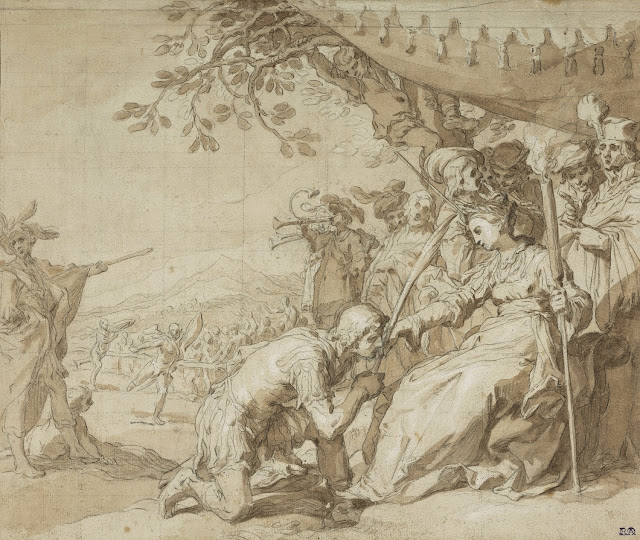 |
| Carlo Bononi Drapery study ca. 1605-1612 drawing Rijksmuseum, Amsterdam |
 |
| Paul Bril Distant view of a town, with trees in foreground ca. 1603-1604 drawing Fitzwilliam Museum, Cambridge |
 |
| Jan Asselijn Landscape ca. 1630-52 drawing Teylers Museum, Haarlem |
 |
| Abraham Bloemaert Chariclea crowning Theagenes ca. 1624-26 drawing National Galleries of Scotland |
The Story of Theagenes and Chariclea, also called An Ethiopian Story, or the Ethiopica, was written in Greek by Heliodorus around A.D. 350 and has come to be generally regarded as the latest surviving important work composed in Classical Greek. It is a long and intricately plotted prose novel, widely imitated by writers of the European Renaissance and on into the eighteenth century, following its western rediscovery in 1526. Chariclea, the daughter of King Hydaspes and Queen Porsine of Ethiopia, was born white because her mother gazed upon a marble statue while pregnant. Fearing an accusation of adultery, Porsine gave her baby daughter into the care of Sisimathras, a gymnosophist, who carried her to Egypt and placed her in charge of Charicles, a Pythian priest. She was then taken to Delphi, and made a priestess of Apollo. Theagenes, a noble Thessalian, comes to Delphi, and the two fall in love. He carries off Chariclea with the help of Calasiris, an Egyptian employed by Porsine to seek for her daughter. Then follow many perils from pirates, bandits, and others, but the chief personages ultimately converge in Ethiopia at the very moment when Chariclea is about to be sacrificed to the gods by her own father. Her birth is made known, and the lovers are happily married.
 |
| Anthony van Dyck Portrait of artist Lucas Vorsterman before 1641 drawing Fitzwilliam Museum, Cambridge |
 |
| Anonymous artist Interior of a farmhouse ca. 1600-1700 drawing National Galleries of Scotland |
 |
| Guido Reni Design for an Altar with the Annunciation before 1642 drawing National Galleries of Scotland |
from Autumn Shade
In nameless warmth, sun light in every corner,
Bending my body over my glowing book,
I share the room. Is it with a voice or touch
Or look, as of an absence, learned by love,
Now, merely mine? Annunciation, specter
Of the worn out, lost, or broken, telling what future.
What vivid loss to come, you change the room
And him who reads here. Restless, he will stir,
Look round, and see the room renewed and line,
Color, and shape as, in desire, they are,
Not shadows but substantial light, explicit,
Bright as glass, inexhaustible, and true.
– Edgar Bowers (1965)
 |
| attributed to Jan Both Rocky landscape before 1652 drawing Metropolitan Museum of Art, New York |
 |
| attributed to Jan Both Mounted herdsman and cows, with city in the background before 1652 drawing Metropolitan Museum of Art, New York |
 |
| Barent Fabritius Youth studying by candlelight ca. 1650-55 drawing Rijksmuseum, Amsterdam |
 |
| Willem Schellinks Stonehenge 1662 drawing British Museum |
from Replica
And Vico says gods and goddesses are the self write large –
selves to make earthquakes, tornadoes, eclipses, selves to lift the sun –
and Vico says all things having been named for the namers, us,
we give a chair arms, legs, a seat and a back, a cup has its lip
and a bottle its neck, and ever after rivers flow from their headwaters
and a well-oiled engine purrs at the center of good feeling.
So take your misery down a notch in aches and pains and little diseases,
in years of photo albums, in journals of dreams interrupted by mornings,
in furniture you built yourself, in copies and imitations,
in scale-model wars and families and the age of fancy automobiles.
And when once in your life you make the big trip to the original,
chances are you'll mainly see your own face in the glass that protects
everything of which there's one only in the form of its only maker.
– Marvin Bell (from Nightworks, 2000)
 |
| Philips Wouwerman Seated Man before 1668 drawing National Galleries of Scotland |
 |
| Leonaert Bramer The Circumcision before 1674 drawing with watercolor Metropolitan Museum of Art, New York |
 |
| Herman Saftleven Figure seated by a group of trees before 1685 drawing National Galleries of Scotland |
 |
| Thomas Wijck Weaver at his loom before 1677 drawing Rijksmuseum, Amsterdam |